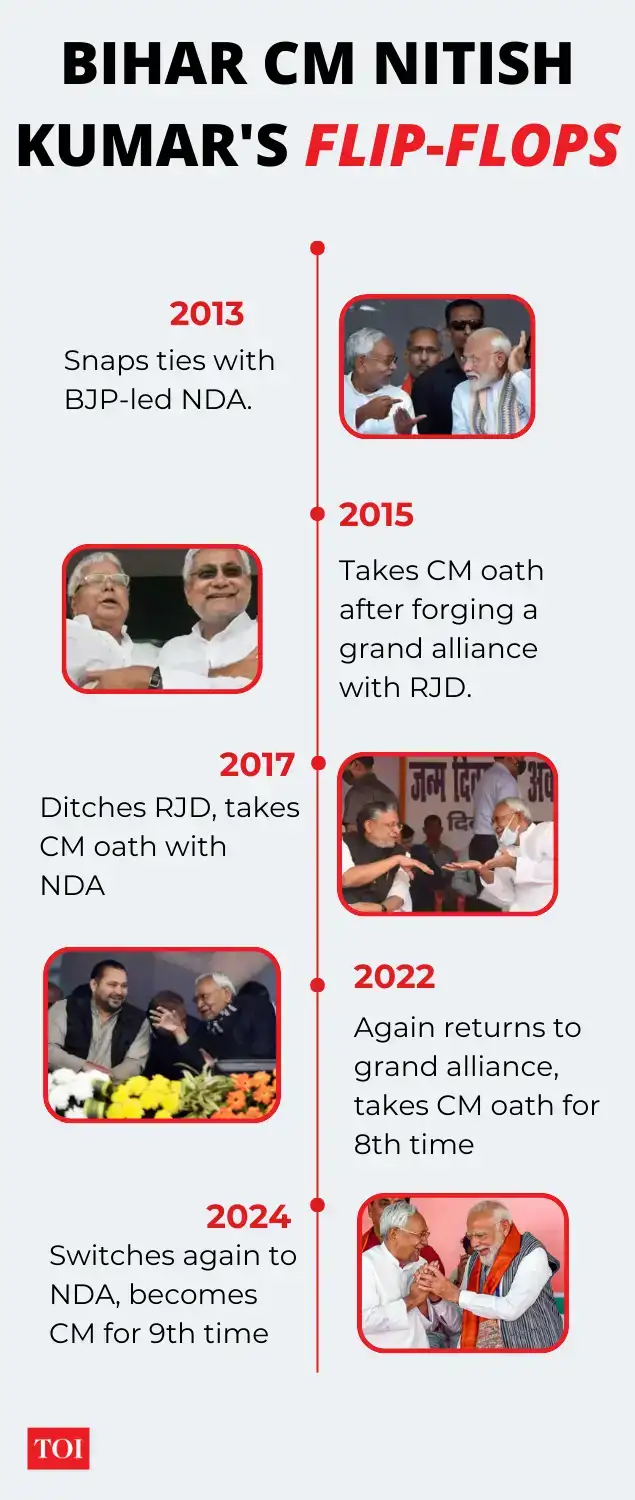NEW DELHI: For over two decades, Nitish Kumar has defied political gravity, fractured mandates and bitter rivals in Bihar to serve as the chief minister of the state. Nitish has remained the pivot around which Bihar’s politics has revolved in the last 20 years. This despite the fact that his party Janata Dal (United) has never won a full majority in the state assembly. Nitish Kumar has alternated between the National Democratic Alliance (NDA) and United Progressive Alliance (UPA) camps at least six times since 1999 earning the dubious distinction of being called the “Paltu Kumar” of Bihar politics.Nitish was with the BJP-led NDA from 1999 to 2013 before switching to the UPA in 2015. In 2017, he returned to the NDA, only to realign with the UPA again in 2022. A year later, he joined the INDIA bloc, but by 2024, he had once again rejoined the NDA.

Ironically, despite these political manoeuvres, Nitish is still courted by every major political force in Bihar. The question then arises: what makes Nitish Kumar indispensable?Nitish Kumar belongs to the Kurmi caste, which makes up only 3 per cent of Bihar’s population. In the initial stages of his political career, Nitish backed heavily on ‘Luv-Kush’ (Kurmi-Kushwaha) support and was recognised as their undisputed leader. Nitish also focussed on development agenda and gained popularity with several of his pro-women policies like prohibition.But over a period of time, Nitish realised that to have an edge over either the RJD or the BJP, he needed to broaden his support base. So, the JD(U) chief made a conscious effort to weave his support base around the entire EBC community by modelling his politics on Karpoori Thakur’s ideals and putting a special focus on the economically weaker section.Nitish gradually placed himself as the “poster boy” of the Extremely Backward Class, which constitutes the largest portion of the population in Bihar.By announcing the caste survey in 2023, Nitish rebooted his politics and claimed his “social justice” credentials. Also through the survey, Nitish formally proclaimed his vote bank, making sure that he or his party cannot be pushed to the margins.Political analyst Kumar Vijay, who has followed politics in Bihar closely for several years, believes that the caste survey was undertaken to project Nitish Kumar as the leader of largest chunk of Bihar’s population.“I firmly believe the caste survey was meant to project Nitish Kumar as the leader of the largest segment of Bihar’s population and not just a Luv-Kush leader.The exercise was also a reminder to the RJD that Nitish commands a broader voter base — around 36 per cent — compared to Lalu Prasad Yadav’s MY (Muslim-Yadav) support base, which accounts for about 32 per cent,” Vijay said.“Building a voter base across 122 castes is not easy. Nitish has introduced several schemes and programs targeting these communities to consolidate his position,” he added.Further, Vijay said that it would be interesting to see how the Muslim voters within the EBS community will vote in the upcoming elections.“Interestingly, Nitish has also been the only NDA leader with some traction among Muslim voters. However, with the recent passage of the new Waqf laws, it remains to be seen how this development might impact his support among the community,” he said.The caste survey found out that there were 122 castes among the EBCs in the state. If the 10 percent Muslim EBCs are discounted, 26 percent is believed to be the strong supporters of Nitish.
How the numbers add up
Now, let’s analyse how JD(U) performed in the 2020 assembly elections. Even though it was the party’s worst performance since 2000, JD(U) still managed to secure 32.83% of the vote in the 115 seats it contested, even when both his ally, the BJP, and the opposition, led by the RJD, weren’t exactly in his corner.This shows Nitish Kumar’s loyal voter base that has largely stuck with him. If the Luv-Kush voters (about 7% Kurmis and Koeris) are combined with the 26% non-Muslim EBCs, the math adds up to 33%.Since 2004, Nitish has filled the lacunae of a leader in the EBC community by starting a host of schemes especially targeting the EBCs, such as the Student Credit Card scheme, scholarship schemes from primary classes, school uniforms, free textbooks, vocational training, and housing and employment schemes.
Challenges ahead
However, in these elections, Nitish Kumar appears to be facing a challenge in the form of Chirag Paswan. Union minister Chirag has recently announced that his party, Lok Janshakti Party (Ram Vilas), will contest all 243 seats in Bihar.This could be a serious matter of concern for Nitish, as the LJP’s vote bank, like that of the JDU, also lies among the EBCs and Scheduled Castes.This election will serve as a litmus test for Nitish’s hold over the EBC vote bank and his projection as their poster boy — more so, in light of his reported health issues, which the opposition has repeatedly raised.

